Coming off of attending my first-ever GEOINT conference (more thoughts on the geointelligence side of things here), I was struck by an unexpected theme as I listened to presentations from across government agencies working on everything from reconnaissance to disaster recovery to defense. There’s a significant workforce skills gap, and the only way to address it may be to rewrite the old ways of doing things when it comes to discovering, recruiting and retaining talent.
In several panels and keynote talks, the speakers addressed a huge problem in their industry, and it wasn’t down to a lack of technology or computing power or security, but was instead a lack of people. The solution to this is to broaden the applicant field - by looking at different fields of education, different racial and ethnic backgrounds, different socioeconomic backgrounds, different educational pathways, and different abilities, including to consider people who are neurodivergent, or otherwise don’t fit the normal stereotype for a government employee. (Even tattoos and piercings were brought up - what difference does someone’s appearance make if that person can develop skills crucial to a mission’s success?).
John Sherman, Chief Information Officer for the Department of Defense, made this a key part of his Wednesday address, stressing that the old ways aren’t working. We “can’t go to the same wells over and over again,” he stressed. “It is going to require deliberate efforts by all of us to expand that aperture and look at who’s out there.”
The need for this “deliberate effort” is far from a token nod to diversity, it is crucial for the continued competitiveness of the technology-related careers in the US. In a Q&A after her keynote, Avril Haines, Director of National Intelligence stressed this point.
“We see recruiting and retaining a talented and diverse workforce as the absolute top priority because we all recognize that our success is fundamentally attached to the people that we have and the talent the skill and commitment that they bring.”
So what are the potential solutions? And what uphill battles still remain?
One pathway to increasing the diversity of the workforce, especially at state or government agencies, is to connect farther back in the educational pipeline. By developing partnerships with community colleges or historically black colleges and universities (HBCUs), companies can help to nurture careers in fields that students might not have otherwise had access to. To be able to envision oneself within a career can be eye-opening, and increasing the visibility and direct involvement of people at these educational institutions can open up new workforce pipelines.
On the topic of neurodiversity, one of the key takeaways of a panel was to stress that even hiring practices may need to change - both at private companies and government agencies - to allow for the differences that someone who is neurodivergent may present.
Neurodivergent is a term used to describe individuals whose neurological development and functioning differ from what is considered typical or "neurotypical." It encompasses a range of conditions, including but not limited to autism, attention deficit hyperactivity disorder (ADHD), dyslexia, dyspraxia, Tourette syndrome, and various other developmental or neurological conditions.
Neurodivergent individuals often have unique patterns of thinking, learning, and experiencing the world. They may possess strengths and challenges that differ from societal norms, and their neurodivergent traits can contribute to their individuality and diversity. Several speakers at GEOINT pointed out that some of these differences may even be particularly well-suited for tasks like imagery analysis or other visually based skillsets, which could actually serve as an advantage to companies that hire those individuals.
But recruitment and exposure to these careers isn’t enough - the practices of hiring, managing, and even security changes can serve as barriers to potential employees outside of the typical applicant pool. Requiring video interviews by Zoom might be difficult for someone with limited access to high-speed internet or technology, for example. A lack of eye contact, which can be normal for someone with autism could be mistaken for evasion in a security screening. Managers may need to be trained on how to interact with people from different cultural backgrounds to make sure that communication and expectations remain clear and productive.
What can we do within our own industries and the companies we work for? I think a good place to start is to try to look beyond those who look, act, and think just like us. Are we really looking for a “culture” fit, or should hiring staff be a process of exploring someone’s potential to add to a company’s skillset in new ways?
This deliberate effort to expand the aperture and seek out untapped talent is crucial for the jobs of the future. To achieve this, it is essential to recognize and embrace the unique strengths and perspectives that neurodivergent individuals can bring to the workforce. Overcoming barriers such as biased hiring practices, lack of accessibility, and cultural differences is vital to creating a more inclusive and diverse work environment. Ultimately, prioritizing talent and embracing diversity is key to the success and advancement of organizations and industries, concluded Sherman.
“If we don’t have the women and men who are motivated, trained, diverse and ready to learn, then the technology is secondary - talent is the most important thing.”






